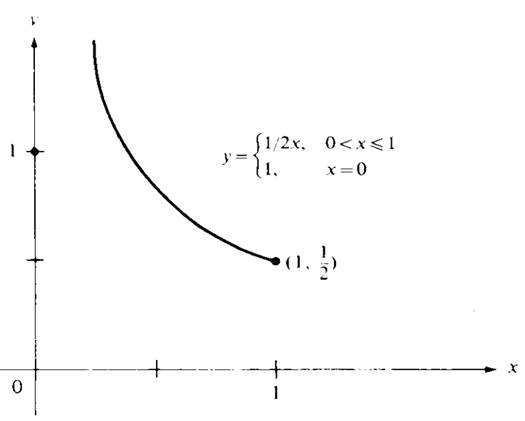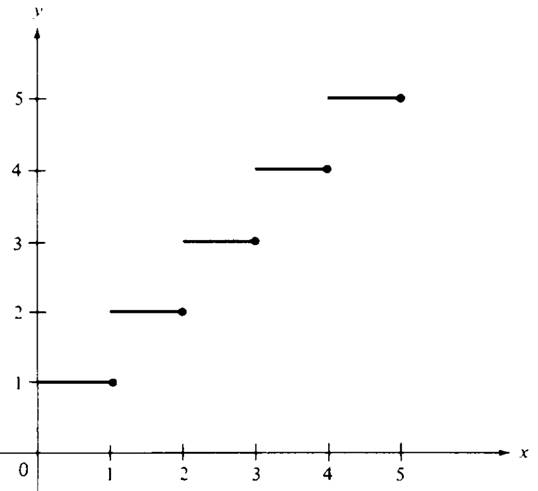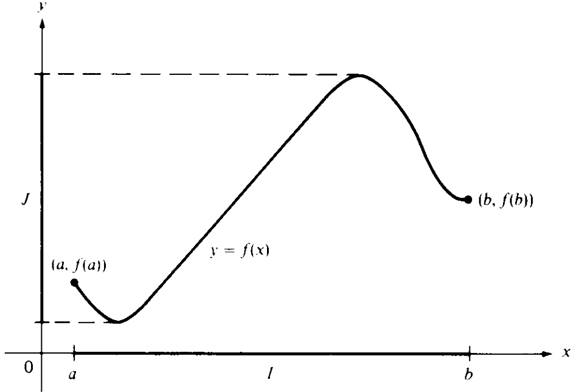In this section we prove an important principle about real numbers that is often used as an axiom in place of Axiom C.
Definitions
A set S of real numbers has the upper bound M if x ≤ M for every number x in S; we also say that the set S is bounded above by M. The set S has the lower bound m if x ≥ m for every number x in S; we also say that S is bounded below by m. A set S is bounded if S has an upper and a lower bound. Suppose that f is a function on R1 whose domain D contains the set S. We denote by f |S the restriction of to the set S; that is, f |S has domain S and f |S(x) f(x) for all x in S. A function f is bounded above, bounded below, or bounded if the set R consisting of the range of f satisfies the corresponding condition.
Suppose we define

Then f is not bounded on S ={x :0 ≤ x ≤ 1}. See Figure 1.1.

Figure 1.1
We now prove the fundamental principle on upper and lower bounds (see Figure 1.2).

Figure 1.2 U is the least upper bound for S.
Theorem 1.1
If a nonempty set S ⊂ R1 has an upper bound M, then it has a least upper bound U; that is, there is a unique number U that is an upper bound for S but is such that no number U`<U is an upper bound for S. If a nonempty set has a lower bound m, it has a greatest lower bound L.
Proof
The second statement follows by applying the first to the set S/={x :−x ∈ S}.We prove the first statement using the Nested intervals theorem.
If M ∈ S, then we may take U= M, since in this case every x in S is less than or equal to U, and if U/<U, then U/is not an upper bound, since U ∈ S and U>U/.If M is not in S, let b1 =M and choose a1 as any point of S. Now, either (a1 + b1)/2 is greater than every x in S, or there is some x in S greater than or equal to (a1 + b1)/2. In the first case, if we define a2 = a1 and b2 = (a1 + b1)/2, then a2 ∈ S and b2 is greater than every x in S. In the second case, choose for a2 one of the numbers in S that is greater than or equal to (a1 + b1)/2 and set b2 = b1; then we again have a2 ∈ S and b2 greater than every x in S. Continuing in this way, we define an infinite sequence {[an,bn]} of closed intervals such that(1.2)

for each n, and so for each n,(1,3)

From the Nested intervals theorem, it follows that there is a unique number U in all these intervals and

Let x be any number in S. Then x<bn for each n, so that x ≤ U by the limit of inequalities. Thus U is an upper bound for S. But now let U/<U and let ε = U – U/ . Then, since an → U, it follows that there is an N such that U/=U − ε<an ≤ U for all n>N. But since all the an ∈ S, it is clear that U/ is not an upper bound. Therefore, U is unique.
Definitions
The number U in Theorem 1.1, the least upper bound, is also called the supremum of S and is denoted by
l. u .b. S or sup S.
The number L of Theorem 1.1, the greatest lower bound, is also called the infimum of S and is denoted by
g. l .b. S or in f S.
Corollary
If x0 is the largest number in S, that is, if x0 ∈ S and x0 is larger than every other number in S, then x0 = sup S. If S is not empty and U= sup S, with U not in S, then there is a sequence {xn} such that each xn is in S and xn → U. Also, if ε> 0 is given, there is an x in S such that x>U − ε. Corresponding results hold for in f S.
These results follow from the definitions and from the proof of Theorem 1.1 With the help of this corollary it is possible to show that the Axiom of Continuity is a consequence of Theorem 1.1.
Definitions
Let f have an interval I of R1 as its domain and a set in R1 as its range.
We say that f is increasing on I if f(x2)>f(x1) whenever x2 >x1. The
function f is non decreasing on I if f(x2) ≥ f(x1) whenever x2 >x1. The
function f is decreasing on I if f(x2)<f(x1) whenever x2 >x1. The
function f is non increasing on I if f(x2) ≤ f(x1) whenever x2 >x1.A
function that has any one of these four properties is called monotone
on I.
Monotone functions are not necessarily continuous, as the following step function exhibits:

See Figure 1.3. Also, monotone functions may not be bounded. The function f : x → 1/(1 − x) is monotone on the interval I ={x :0 ≤ x< 1} but is not bounded there.

Figure 1.3 A step function.
If a function f defined on an interval I is continuous on I, then an extension of the Intermediate-value theorem shows that the range of f is an interval. In order to establish this result, we use the following characterization of an interval on R1.
Theorem 1.2
A set S in R1is an interval ⇔ (i) S contains more than one point and (ii) for every x1,x2 ∈ S the number x is in S whenever x ∈ (x1,x2).
Proof
If S is an interval, then clearly the two properties hold. Therefore, we suppose that (i) and (ii) hold and show that S is an interval. We consider two cases.
Case 1: S is bounded. Define a = inf S and b =sup S. Let x be an element of the open interval (a, b). We shall show that x ∈ S.
Since a = inf S, we use the corollary to Theorem 1.1 to assert that there is an x1 ∈ S with x1 <x. Also, since b = sup S, there is an x2 in S with x2 >x. Hence x ∈ (x1,x2), which by (ii) of the hypothesis shows that x ∈ S. We conclude that every element of (a, b) is in S. Thus S is either a closed interval, an open interval, or a half-open interval; its endpoints are a, b.
Case 2: S is unbounded in one direction. Assume that S is unbounded above and bounded below, the case of S bounded above and unbounded below being similar. Let a= inf S. Then S ⊂ [a,∞). Let x be any number such that x>a. We shall show that x ∈ S. As in Case 1, there is a number x1 ∈ S such that x1 <x. Since S has no upper bound there is an x2 ∈ S such that x2 >x. Using (ii) of the hypothesis, we conclude that x ∈ S. Therefore, S = [a,∞) or S= (a,∞).
We now establish a stronger form of the Intermediate-value theorem.
Theorem 1.3
Suppose that the domain of f is an interval I and f is continuous on I. Assume that f is not constant on I. Then the range of f , denoted by J , is an interval.
Proof
We shall show that J has properties(i) and (ii) of Theorem 1.2 and therefore is an interval. Since f is not constant, its range must have more than one point, and property (i) is established. Now let y1,y2 ∈ J . Then there are numbers x1,x2 ∈ I such that f(x1) = y1 and f(x2) = y2. We may assume that x1 <x2. The function f is continuous on [x1,x2], and so we may apply the Intermediate-value theorem. If c is any number between y1 and y2, there is an x0 ∈ [x1,x2] such that f(x0) = c. Thus c ∈ J , and we have established property (ii). The set J is an interval.
If f is continuous on I ={x : a ≤ x ≤ b}, it is not necessarily the case that J is determined by f(a) and f(b). Figure 1.4 shows that J may exceed the interval [f(a), f(b)]. In fact, I may be bounded and J unbounded, as is illustrated by the function f : x → 1/x with I ={x :0 <x< 1}.The range is J ={y :1 <y< ∞}. The function f : x → 1/(1 + x2) with I ={x :0 <x< ∞} and J ={y :0 <y< 1} is an example of a continuous function with an unbounded domain and a bounded range.
Consider the restriction to [0,∞) of the function f : x → xn where n is a positive integer. By Theorem1.3, the range of f is an interval, which must be [0,∞), since f(0) = 0, f is increasing, and f(x) →+∞ as x →+∞.
Hence, for each x ≥ 0, there isat least one number y ≥ 0 such that yn = x. If y/>y, then (y/)n >yn = x. Also, if 0 ≤ y/<y, then (y/)n <x.
Thus the solution y is unique. We denote it by x1/n. Every positive number has an nth root for every positive integer n. The function x → x1/n, x ≥ 0, can be shown to be continuous on [0,∞).

Figure 1.4
Problems
In Problems1 through 8 find l.u.b. S and g.l.b. S. State whether or not these numbers are in S.

Basic Elements of Real Analysis, Murray H. Protter, Springer, 1998 .Page(44-53)
 الاكثر قراءة في التحليل الحقيقي
الاكثر قراءة في التحليل الحقيقي
 اخر الاخبار
اخر الاخبار
اخبار العتبة العباسية المقدسة


